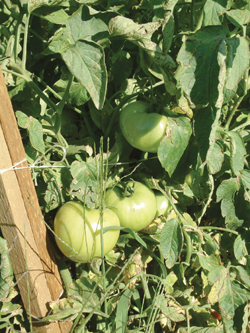
Features
Production
Research
Study could lead to tomato plants with stronger defences
with stronger defences
March 27, 2008 By Fruit & Vegetable
Producing that red, juicy tomato
can be a challenge for farmers, who must battle insects and diseases
from the moment the young plants spring from the ground until the last
tomato on the vine is picked.
 Producing that red, juicy tomato can be a challenge for farmers, who must battle insects and diseases from the moment the young plants spring from the ground until the last tomato on the vine is picked.
Producing that red, juicy tomato can be a challenge for farmers, who must battle insects and diseases from the moment the young plants spring from the ground until the last tomato on the vine is picked.
Researchers in the plant-biology laboratory of Dr. Johannes Stratmann at the University of South Carolina are seeking to discover how tomato plants defend themselves against plant-eating insects, such as caterpillars, and microorganisms. Their discovery could help scientists develop new tomato varieties with stronger defense systems to battle the insects, bacteria, fungi and viruses that threaten and destroy crops.
“Tomatoes are frequently attacked by a number of enemies – insects and microbial pathogens alike,” says Dr. Stratmann, whose research team includes USC undergraduate biology students Wayne Miller of Greenville and Suchita Pancholi of Columbia. “ But they have a very effective and sophisticated defense system that has evolved over millions of years.
“We are trying to understand these defense mechanisms at the molecular level. Our research could help other scientists develop new crop plants that are effective in battling insects and other stressors. But before we can develop better plants, we have to know how the plant works.”
Stratmann likens the workings of the tomato plant’s cellular defense system to a radio, where waves are perceived by the antenna and relayed to a transistor that amplifies the signal, producing sound.
“We see a similar situation in a cell,” explains Stratmann. “When tomato plants are attacked and wounded by plant-eating insects, a small peptide (protein) called systemin is released at the wound site.”
At a target cell, the systemin interacts with a receptor, the equivalent of the radio antenna. The systemin signal is then amplified along a so-called “signal transduction pathway.” Ultimately, defense genes are activated. These genes encode proteins that block digestive enzymes in the insects’ guts. This reduces the growth of the attacking insects, which begin to starve or move on to other plants.
Miller is looking at a protein that functions in the signal transduction pathway of systemin. To characterize the function of this protein, he engineered a harmless plant virus that turns off the gene that encodes the signaling protein. The assumption is that when the gene is turned off, the signal transduction should be interrupted and the defense response halted, thus proving the protein is essential for the defense response.
“This technique is giving us an understanding of the signal pathways involved in the plant’s defense system,” explains Miller, a senior who wants to continue graduate studies in plant biology. “Our work on signaling genes is proving to be successful.”
Pancholi, a USC senior who hopes for a career in research or medicine, is working on another signaling protein, which is part of the systemin signaling pathway. She is studying how this protein responds to wound signals that are generated by insects at the wound site and travel to distant parts of the plant.
These signals are very fast, with a speed of up to one inch per second. It is thought that the signals prepare the entire plant for an attack by an insect. Pancholi’s work with Stratmann will help provide clues for biotechnology on how to alter the signaling pathways in crop plants to make them more resistant to the stresses they encounter.
Print this page